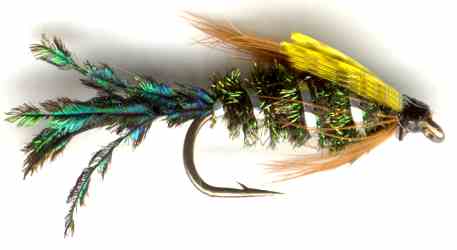The Zug Bug Nymph Fly
The Zug bug was originally designed in the 1930's by J.Cliff Zug in West Lawn, Pennsylvania, USA and it became a popular fly within the Catskills Mountain region.

NYMPH FLY PATTERNS. Hook size 10 12 14 16 18 20 - $US each
The Zug Bug Nymph fly pattern is thought to be a variation of a nymph called the kemp bug. In the 1940's its popularity spread to the mountainous regions of Western America. It was used successfully in Yellowstone National Park and the Sierra Nevada. It is one of those must have flies. It rates along with Pheasant Tail nymphs, Gold Ribbed Hare's Ear nymphs and Prince's nymph as one of the top 10 nymphs that you must have in your fly box. It is the use of the green Peacock Herl and Peacock Sword for the tail gives this fly it's efflorescent qualities that makes it so alluring and successful. It can also be used as a stonefly imitation. Cliff Zug developed the zug bug to imitate cased caddis and caddis larvae. The design demands that the wingcase is only tied down at the front near the eye of the hook. This gives the zug bug a juvenile caddis-type wing appearance. I have had success with using a zugbug as part of a dropper rig. In slow moving streams it works great near the bottom fished dead a drift on the current.
Some artificial fishing flies try to imitate the fish's food at the different stages of an insect's life. A good example is the Mayfly. They all have upright wings and two or three long tails. There are five stages in the metamorphosis and life of the mayfly: egg, nymph, dun, spinner, and spent. Mayflies are commonly called "up-winged" flies. They are recognized as being the staple diet of the trout. They are delicate insects with cylindrical bodies and two pairs of erect veined wings. Some mayfly species can be found at almost anytime of the year but others emerge only during certain times between the four month period from May to August. The term "Mayfly" applies to all these species and not just the flies that hatch in May.
This group of fly fishing flies is tied to imitate the natural insects of the order Ephemeroptera. If you are saying that big word sounds Greek to me you would be 100% correct. 'Ephemeros' is Greek for 'lasting a day' and 'pteron' means 'a wing'. Most adults live less than a day and in some species they survive for only a matter of minutes. There are 2,500 species in the world: 46 in the UK, 85 in Australia and 611 in North America. In a typical stream there may be a few hundred or a few thousand mayfly nymphs per square yard/metre. Mayflies do not have any defenses against those that prey on them. What they lack in defense they make up for in numbers. They are an extremely important element of all freshwater fish's diets.
There are thousands of fly patterns tied to imitate these insects at the different stages of their development. There is a lot of folklore and fishing jargon surrounding these flies that confuses the beginner. The best advice when you first start fly fishing is to ignore it all. Stop trying to match the natural insect with an exact named representation. Unlike other insect groups mayflies all look very similar and do much the same as other mayflies. Keep a range of imitations in your fly box to cover the life cycle of these insects from aquatic nymph to the spent dead mayfly floating on the water surface. Use the one that looks most like your local flies.


Fly Fishing books

